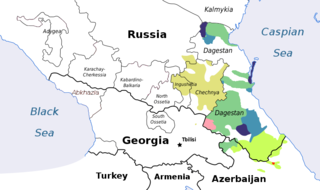A grammatical case is a category of nouns and noun modifiers that corresponds to one or more potential grammatical functions for a nominal group in a wording. In various languages, nominal groups consisting of a noun and its modifiers belong to one of a few such categories. For instance, in English, one says I see them and they see me: the nominative pronouns I/they represent the perceiver and the accusative pronouns me/them represent the phenomenon perceived. Here, nominative and accusative are cases, that is, categories of pronouns corresponding to the functions they have in representation.

The Northeast Caucasian languages, also called East Caucasian, Nakh-Daghestani or Vainakh-Daghestani, or sometimes Caspian languages, is a family of languages spoken in the Russian republics of Dagestan, Chechnya and Ingushetia and in Northern Azerbaijan as well as in Georgia and diaspora populations in Western Europe and the Middle East. According to Glottolog, there are currently 36 Nakh-Dagestanian languages.

Ubykh or Päkhy is an extinct Northwest Caucasian language once spoken by the Ubykh people, a subgroup of Circassians who originally inhabited the eastern coast of the Black Sea before being deported en masse to the Ottoman Empire in the Circassian genocide.

Abkhaz, also known as Abkhazian, is a Northwest Caucasian language most closely related to Abaza. It is spoken mostly by the Abkhaz people. It is one of the official languages of Abkhazia, where around 100,000 people speak it. Furthermore, it is spoken by thousands of members of the Abkhazian diaspora in Turkey, Georgia's autonomous republic of Adjara, Syria, Jordan, and several Western countries. 27 October is the day of the Abkhazian language in Georgia.
Hurrian is an extinct Hurro-Urartian language spoken by the Hurrians (Khurrites), a people who entered northern Mesopotamia around 2300 BC and had mostly vanished by 1000 BC. Hurrian was the language of the Mitanni kingdom in northern Mesopotamia and was likely spoken at least initially in Hurrian settlements in modern-day Syria.
In linguistic typology, ergative–absolutive alignment is a type of morphosyntactic alignment in which the single argument ("subject") of an intransitive verb behaves like the object of a transitive verb, and differently from the agent ("subject") of a transitive verb. Examples include Basque, Georgian, Mayan, Tibetan, and certain Indo-European languages. It has also been attributed to the Semitic modern Aramaic languages. Ergative languages are classified into 2 groups: those that are morphologically ergative but syntactically behave as accusative and those that—on top of being ergative morphologically—also show ergativity in syntax. No language has been recorded in which both the morphological and syntactical ergative are present. Languages that belong to the former group are more numerous than those to the latter. Dyirbal is said to be the only representative of syntactic ergativity, yet it displays accusative alignment with certain pronouns.
Lezgian, also called Lezgi or Lezgin, is a Northeast Caucasian language. It is spoken by the Lezgins, who live in southern Dagestan (Russia); northern Azerbaijan; and to a much lesser degree Turkmenistan; Uzbekistan; Kazakhstan; Turkey, and other countries. It is a much-written literary language and an official language of Dagestan. It is classified as "vulnerable" by UNESCO's Atlas of the World's Languages in Danger.

Alyutor or Alutor is a language of Russia that belongs to the Chukotkan branch of the Chukotko-Kamchatkan languages.
Tsez, also known as Dido, is a Northeast Caucasian language with about 15,000 speakers spoken by the Tsez, a Muslim people in the mountainous Tsunta District of southwestern Dagestan in Russia. The name is said to derive from the Tsez word for "eagle", but this is most likely a folk etymology. The name Dido is derived from the Georgian word დიდი, meaning "big".
Hunzib is a Northeast Caucasian language spoken by the Hunzib people in southern Dagestan, near the Russian border with Georgia.
Aghul is a Northeast Caucasian language spoken by the Aghuls in southern Dagestan, Russia and in Azerbaijan. It is spoken by about 29,300 people.
Canela is a dialect of the Canela-Krahô language, a Timbira variety of the Northern Jê language group spoken by the Apànjêkra (Apaniêkrá) and by the Mẽmõrtũmre in Maranhão, Brazil.
Khwarshi is a Northeast Caucasian language spoken in the Tsumadinsky-, Kizilyurtovsky- and Khasavyurtovsky districts of Dagestan by the Khwarshi people. The exact number of speakers is not known, but the linguist Zaira Khalilova, who has carried out fieldwork in the period from 2005 to 2009, gives the figure 8,500. Other sources give much lower figures, such as Ethnologue with the figure 1,870 and the latest population census of Russia with the figure 1,872. The low figures are because many Khwarshi have registered themselves as being Avar speakers, because Avar is their literary language.

Wagiman, also spelt Wageman, Wakiman, Wogeman, and other variants, is a near-extinct Aboriginal Australian language spoken by a small number of Wagiman people in and around Pine Creek, in the Katherine Region of the Northern Territory.
The Hinuq language is a Northeast Caucasian language of the Tsezic subgroup. It is spoken by about 200 to 500 people, the Hinukhs, in the Tsuntinsky District of southwestern Dagestan, mainly in the village of Genukh. Hinukh is very closely related to Tsez, but they are not entirely mutually intelligible.
The Akhvakh language is a Northeast Caucasian language from the Avar–Andic branch. Ethnologue lists 210 speakers based on the 2010 census, but Magomedova and Abulaeva (2007) list 20,000 speakers of the language. Akhvakh has several dialects, though sources do not agree on the number. Ethnologue lists Kaxib, Northern Akhvakh and Southern Akhvakh. Creissels (2010) lists Northern Akhvakh and three dialects of Southern Akhvakh.
Chirag is a language in the Dargin dialect continuum spoken in Dagestan, Russia. It is often considered a divergent dialect of Dargwa. Ethnologue lists it under the dialects of Dargwa but recognizes that it may be a separate language.

The Yukulta language, also spelt Yugulda, Yokula, Yukala, Jugula, and Jakula, and also known as Ganggalidda, is an extinct Tangkic language spoken in Queensland and Northern Territory, Australia. It was spoken by the Yukulta people, whose traditional lands lie on the southern coast of the Gulf of Carpentaria.
Nen is a Yam language spoken in the Bimadbn village in the Western Province of Papua New Guinea, with 250 speakers as of a 2002 SIL survey. It is situated between the speech communities of Nambu and Idi.
Ubykh was a polysynthetic language with a high degree of agglutination that had an ergative-absolutive alignment.






